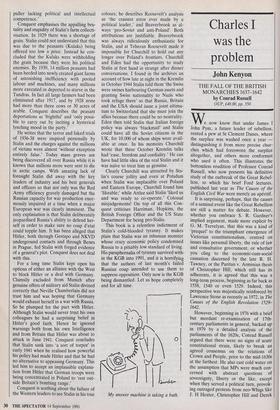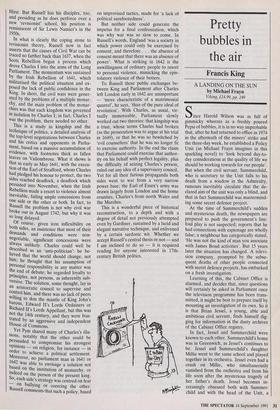Charles I was the problem
John Kenyon
THE FALL OF THE BRITISH MONARCHIES 1637-1642 by Conrad Russell OUP, £40.00, pp. 550 We now know that under James I John Pym, a future leader of rebellion, rented a pew at St Clement Danes, where the surplice was washed once a year distinguishing it from more precise chur- ches which had foresworn the surplice altogether, and others more conformist who used it often. This illustrates the bottomless erudition of Professor Conrad Russell, who now presents his definitive study of the outbreak of the Great Rebel- lion, to which his brief Ford lectures, published last year as The Causes of the English Civil War were merely an aperitif.
It is surprising, perhaps, that the causes of a seminal event like the Great Rebellion are still a matter for debate. However, whether you embrace S. R. Gardner's implied argument, made more explicit by G. M. Trevelyan, that this was a kind of `prequel' to the triumphant emergence of Victorian constitutionalism, centred on issues like personal liberty, the rule of law and consultative government, or whether you cling to the economic-cum-social causation discerned by the late R. H. Tawney, or the Puritan v. Arminian thesis of Christopher Hill, which still has its adherents, it is agreed that this was a long-term process, beginning as far back as 1558, 1540 or even 1529. Indeed, this perspective was majestically reinforced by Lawrence Stone as recently as 1972, in The Causes of the English Revolution 1529- 1642.
However, beginning in 1976 with a brief but mordant re-examination of 17th- century parliaments in general, backed up in 1979 by a detailed analysis of the parliaments of the 1620s, Conrad Russell argued that there were no signs of acute constitutional strain, likely to break an agreed consensus on the relations of Crown and People, prior to the mid-1630s at the farthest. He also cast cold water on the assumption that MPs were much con- cerned with abstract questions of sovereignty, liberty or the like, except when they served a political turn, provok- ing outraged protests from neo-Whigs like J. H Hexter, Christopher Hill and Derek Hirst. But Russell has his disciples, too, and presiding as he does perforce over a new 'revisionist' school, his position is reminiscent of Sir Lewis Namier's in the 1950s.
In what is clearly the coping stone to revisionist theory, Russell now in fact asserts that the causes of Civil War can be traced no farther back than 1637, when the Scots Rebellion began a process which drove Charles I into the arms of the Long Parliament. The momentum was sustained by the Irish Rebellion of 1641, which militarised the political situation and ex- posed the lack of public confidence in the King. In short, the civil wars were gener- ated by the problems of a multiple monar- chy, and the main problem of the monar- chies was that each kingdom was governed in isolation by Charles I; in fact, Charles I was the problem, there needed no other.
This is a study in kingship and the technique of politics, a detailed analysis of the top-level negotiations between Charles and his critics and opponents in Parlia- ment, based on a massive accumulation of evidence, with footnotes thick as fallen leaves on Vallombrosa. What it shows is that as early as May 1641, with the execu- tion of the Earl of Strafford, whom Charles had pledged his honour to protect, the two sides reached deadlock, a deadlock which persisted into November, when the Irish Rebellion made a resort to violence almost inevitable, failing ample concessions from one side or the other or both. In fact, to Russell the problem is not why civil war broke out in August 1742, but why it was so long delayed. Of course, given iron inflexibility on both sides, an insistence that most of their demands and conditions were non- negotiable, significant concessions were always unlikely. Charles could well be described as an 'anti-politician': he be- lieved that the world should change, not him; he thought that his assumption of personal responsibility in any matter was the end of debate; he regarded loyalty to principles, not persons, as inherently sub- versive. The solution, some thought, lay in an aristocratic council to supervise and control him, and there was no lack of peers willing to don the mantle of King John's barons, Edward II's Lords Ordainers or Richard II's Lords Appellant, but this was not the 14th century, and they were frus- trated by an aggressive and independent House of Commons. Yet Pym shared many of Charles's illu- sions, notably that the other could be persuaded to compromise his strongest opinions — on religion, for instance — in order to achieve a political settlement. Moreover, no parliament man in 1641 or 1642 was able to envisage a solution not based on the institution of monarchy, or indeed on the person of the present king. So, each side's strategy was centred on fear — on bullying or coercing the other. Russell comments that such a policy, based on improvised tactics, made for 'a lack of political surefootedness'.
But neither side could generate the impetus for a final confrontation, which was why war was so slow to come. In Russell's words, England 'was a society in which power could only be exercised by consent, and therefore . . . the absence of consent meant that there was an absence of power'. What is striking in 1642 is the unwillingness of ordinary people to resort to personal violence, mimicking the epis- tolatory violence of their betters. To Russell these public exchanges be- tween King and Parliament after Charles left London early in 1642 are unimportant — 'more characteristic of a matrimonial quarrel', he says, 'than of the pure ideal of revolution'. With Charles, as usual, vir- tually immoveable, Parliament slowly worked out two theories: that kingship was a trust, whose terms Charles had broken (as the prosecution was to argue at his trial in 1649), or that he was so bewitched by `evil counsellors' that he was no longer fit to exercise authority. In the end the claim that Parliament could exercise that author- ity on his behalf with perfect legality, plus the difficulty of seizing Charles's person, ruled out any idea of a supervisory council. Yet for all their furious propaganda both sides went to war from a very narrow power base; the Earl of Essex's army was drawn largely from London and the home counties, Charles's from north Wales and the Marches.
This is a wonderful piece of historical reconstruction, to a depth and with a degree of detail not previously attempted even by Gardiner, sustained by a lucid and elegant narrative technique, and enlivened by a certain sardonic wit. Whether we accept Russell's central thesis or not — and I am inclined to do so — it is required reading for anyone interested in 17th- century British politics.



















































 Previous page
Previous page